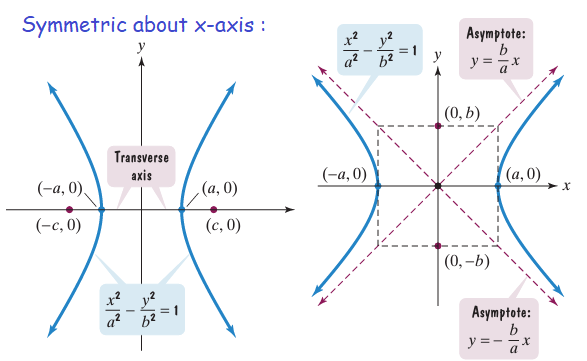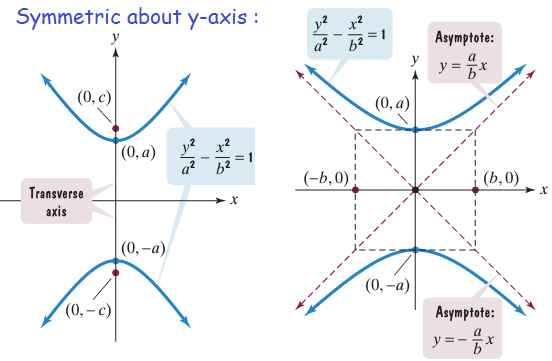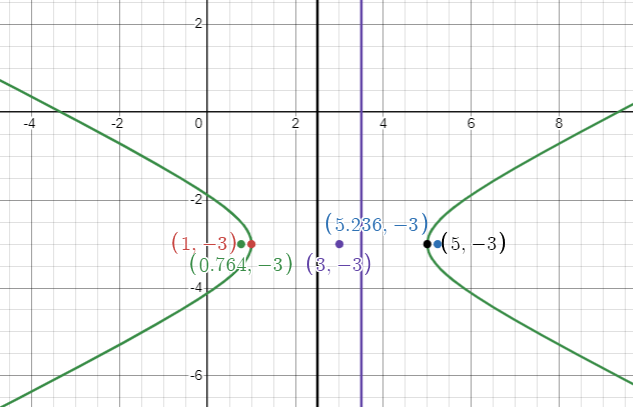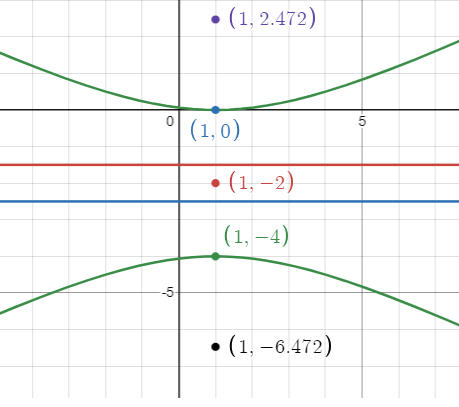FINDING VERTICES FOCI AND ASYMPTOTES FOR HYPERBOLA
Equation of Hyperbola
Equation of hyperbola which is symmetric about x-axis.

Equation of hyperbola which is symmetric about y-axis.

Use the vertices and asymptotes to graph each hyperbola. Locate the foci and find the equation of asymptotes.
Problem 1 :
Solution :
From the given equation, x2 is the first term. Then the hyperbola is symmetric about x-axis.
a2 = 9 and b2 = 16
a = 3 and b = 4
Center :
C (0, 0)
Vertices :
A(a, 0) and A'(-a, 0)
A(3, 0) and A'(-3, 0)
For hyperbola,
c2 = a2 + b2
c2 = 32 + 42
c2 = 9 + 16
c2 = 25
c = 5
Foci :
F1 (c, 0) and F2 (-c, 0)
F1 (5, 0) and F2 (-5, 0)
Equation of asymptotes :
Since the hyperbola is symmetric about x-axis, the equations of asymptotes are y = (-b/a)x and y = (b/a)x
Here a = 3 and b = 4
y = (-4/3) and y = (4/3) x
Problem 2 :
Solution :
From the given equation, x2 is the first term. Then the hyperbola is symmetric about x-axis.
a2 = 100 and b2 = 64
a = 10 and b = 8
Center :
C (0, 0)
Vertices :
A(a, 0) and A'(-a, 0)
A(10, 0) and A'(-10, 0)
For hyperbola,
c2 = a2 + b2
c2 = 102 + 82
c2 = 100 + 64
c2 = 164
c = √164
= 2√41
Foci :
F1 (c, 0) and F2 (-c, 0)
F1 (2√41, 0) and F2 (-2√41, 0)
Equation of asymptotes :
Since the hyperbola is symmetric about x-axis, the equations of asymptotes are y = (-b/a)x and y = (b/a)x
Here a = 10 and b = 8
y = (-8/10) and y = (8/10) x
y = (-4/5) and y = (4/5) x
Problem 3 :
Solution :
From the given equation, y2 is the first term. Then the hyperbola is symmetric about y-axis.
a2 = 16 and b2 = 36
a = 4 and b = 6
Center :
C (0, 0)
Vertices :
A(0, a) and A'(0, -a)
A(0, 4) and A'(0, -4)
For hyperbola,
c2 = a2 + b2
c2 = 42 + 62
c2 = 16 + 36
c2 = 52
c = √52
= 2√13
Foci :
F1 (0, c) and F2 (0, -c)
F1 (0, 2√13) and F2 (0, 2√13)
Equation of asymptotes :
Since the hyperbola is symmetric about y-axis, the equations of asymptotes are y = (-a/b)x and y = (a/b)x
Here a = 4 and b = 6
y = (-4/6)x and y = (4/6) x
y = (-2/3)x and y = (2/3) x
Problem 4 :
4y2 - x2 = 1
Solution :
4y2 - x2 = 1
From the given equation, y2 is the first term. Then the hyperbola is symmetric about y-axis.
a2 = 1/4 and b2 = 1
a = 1/2 and b = 1
Center :
C (0, 0)
Vertices :
A(0, a) and A'(0, -a)
A(0, 1/2) and A'(0, -1/2)
For hyperbola,
c2 = a2 + b2
c2 = (1/2)2 + 12
c2 = (1/4) + 1
c2 = 5/4
c = √5/2
Foci :
F1 (0, c) and F2 (0, -c)
F1 (0, √5/2) and F2 (0, -√5/2)
Equation of asymptotes :
Since the hyperbola is symmetric about y-axis, the equations of asymptotes are y = (-a/b)x and y = (a/b)x
Here a = 1/2 and b = 1
y = (-1/2)x and y = (1/2) x
Problem 5 :
(x - 3)2 - 4(y + 3)2 = 4
Solution :
(x - 3)2 - 4(y + 3)2 = 4
Dividing by 4 on both sides.
From the given equation, x2 is the first term. Then the hyperbola is symmetric about x-axis.
a2 = 4 and b2 = 1
a = 2 and b = 1
Center :
Comparing the given equation with
(x - h)2/a2 - (y - k)2/b2 = 1
C (h, k) ==> (3, -3)
Vertices :
A(h + a, k) and A'(h - a, k)
h = 3, a = 2
h + a => 3 + 2
h - a => 3 - 2 = 1
A(5, -3) and A'(1, -3)
For hyperbola,
c2 = a2 + b2
c2 = 22 + 12
c2 = 4 + 1
c2 = 5
c = √5
Foci :
F1(h + c, k) and F2 (h - c, k)
Here h = 3 and c = √5
h + c ==> 3 + √5
h - c ==> 3 - √5
F1 (3 + √5 , -3) and F2 (3 - √5 , -3)
Equation of asymptotes :
Since the hyperbola is symmetric about x-axis, the equations of asymptotes are
y - k = ±(b/a)(x - h)
y - (-3) = ±(1/2)(x - 3)
y + 3 = ±(1/2)(x - 3)
|
y + 3 = (1/2)x - (3/2) y = (1/2)x - (3/2) - 3 y = (1/2)x - (9/2) |
y + 3 = (-1/2)x + (3/2) y = (-1/2)x + (3/2) - 3 y = (-1/2)x + (-3/2) |

Problem 6 :
Solution :
From the given equation, y2 is the first term. Then the hyperbola is symmetric about y-axis.
a2 = 4 and b2 = 16
a = 2 and b = 4
Center :
Comparing the given equation with
(y - k)2/a2 - (x - h)2/b2 = 1
C (h, k) ==> (1, -2)
Vertices :
A(h, k + a) and A'(h, k - a)
h = 1, a = 2
k + a => -2 + 2 = 0
k - a => -2 - 2 = -4
A(1, 0) and A'(1, -4)
For hyperbola,
c2 = a2 + b2
c2 = 22 + 42
c2 = 4 + 16
c2 = 20
c = 2√5
Foci :
F1(h, k + c) and F2 (h, k - c)
Here h = 1 and c = 2√5
k + c ==> -2 + 2√5
k - c ==> -2 - 2√5
F1 (1, -2 + 2√5 ) and F2 (1, -2 - 2√5)
Equation of asymptotes :
Since the hyperbola is symmetric about y-axis, the equations of asymptotes are
y - k = ±(a/b)(x - h)
a = 2, b = 4, h = 1 and k = -2
y - (-2) = ±(2/4)(x - 1)
y + 2 = ±(2/4)(x - 1)
y + 2 = ±(1/2)(x - 1)
|
y + 2 = (1/2)(x - 1) y + 2 = (1/2)x - (1/2) y = (1/2)x - (1/2) - 2 y = (1/2)x - (5/2) |
y + 2 = (-1/2)(x - 1) y + 2 = (-1/2)x + (1/2) y = (-1/2)x + (1/2) - 2 y = (-1/2)x - (3/2) |

Recent Articles
-
Finding Range of Values Inequality Problems
May 21, 24 08:51 PM
Finding Range of Values Inequality Problems -
Solving Two Step Inequality Word Problems
May 21, 24 08:51 AM
Solving Two Step Inequality Word Problems -
Exponential Function Context and Data Modeling
May 20, 24 10:45 PM
Exponential Function Context and Data Modeling